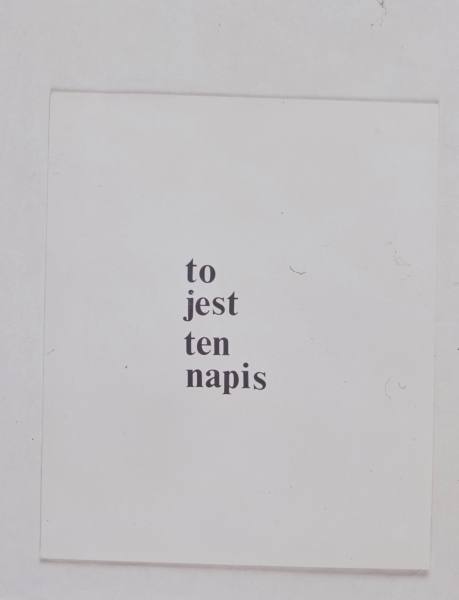Paweł Kwiek
This is the inscription. This is a photograph of the inscription
This is the inscription. This is a photograph of the inscription is a conceptual work that consists of two photographs. The first one shows the sentence “this is the inscription”, so the photography focuses only on the content of the sentence, ignoring the medium in which it is presented. The second photo shows the phrase “this is a photograph of this inscription”, which indicates the medium of photography. The information contained in these sentences fundamentally changes our view of the situation. Although in both cases they are photographs, only in the second we pay attention to that fact, involuntarily treating the first sentence as merely a textual message. The piece, belonging to the neo-avant-garde stage in Kwiek’s work, shows that when looking at a photograph, we do not always realise that this is the medium are dealing with. We often treat photography as if it were the reality.
This work is an element of conceptual considerations about the media used in art. It also addresses the question to what extent a work of art (or some component of it) is autonomous, and to what extent it interacts with the surrounding world. If the above sentences functioned separately, we would treat the former as autonomous, and the latter as referring to something beyond itself. The sentences in the list are complementary and related to one another; the second sentence supplements the first. This kind of neo-avant-garde art is definitely cognitive, rather than concerned with aesthetics.
Paweł Kwiek is the author of films, photography, paintings and artistic actions. In 1973, he graduated from the State Higher School of Film, Television and Theatre in Łódź. He lectured at the Academy of Fine Arts in Warsaw and at PWSFTviT, where he was also the co-founder of the Workshop of Film Form, a creative group exploring the possibilities and specifics of the film, photographic and television medium. His 1970s pieces are among the greatest achievements of the Polish neo-avant-garde movement. During the 1980s, he experienced a spiritual turn, which he describes as “conversion” and since then he has called his art the “sacred avant-garde.”
